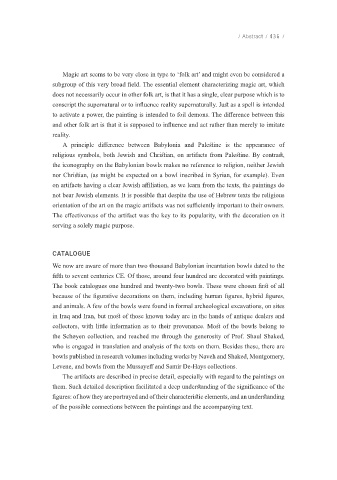Page 438 - שערות לילית וקרני אשמדאי / נעמה וילוז'ני
P. 438
/ Abstract / 436 /
Magic art seems to be very close in type to ‘folk art’ and might even be considered a
subgroup of this very broad field. The essential element characterizing magic art, which
does not necessarily occur in other folk art, is that it has a single, clear purpose which is to
conscript the supernatural or to influence reality supernaturally. Just as a spell is intended
to activate a power, the painting is intended to foil demons. The difference between this
and other folk art is that it is supposed to influence and act rather than merely to imitate
reality.
A principle difference between Babylonia and Palestine is the appearance of
religious symbols, both Jewish and Christian, on artifacts from Palestine. By contrast,
the iconography on the Babylonian bowls makes no reference to religion, neither Jewish
nor Christian, (as might be expected on a bowl inscribed in Syrian, for example). Even
on artifacts having a clear Jewish affiliation, as we learn from the texts, the paintings do
not bear Jewish elements. It is possible that despite the use of Hebrew texts the religious
orientation of the art on the magic artifacts was not sufficiently important to their owners.
The effectiveness of the artifact was the key to its popularity, with the decoration on it
serving a solely magic purpose.
CATALOGUE
We now are aware of more than two thousand Babylonian incantation bowls dated to the
fifth to sevent centuries CE. Of those, around four hundred are decorated with paintings.
The book catalogues one hundred and twenty-two bowls. These were chosen first of all
because of the figurative decorations on them, including human figures, hybrid figures,
and animals. A few of the bowls were found in formal archeological excavations, on sites
in Iraq and Iran, but most of those known today are in the hands of antique dealers and
collectors, with little information as to their provenance. Most of the bowls belong to
the Schøyen collection, and reached me through the generosity of Prof. Shaul Shaked,
who is engaged in translation and analysis of the texts on them. Besides these, there are
bowls published in research volumes including works by Naveh and Shaked, Montgomery,
Levene, and bowls from the Mussayeff and Samir De-Hays collections.
The artifacts are described in precise detail, especially with regard to the paintings on
them. Such detailed description facilitated a deep understanding of the significance of the
figures: of how they are portrayed and of their characteristic elements, and an understanding
of the possible connections between the paintings and the accompanying text.

